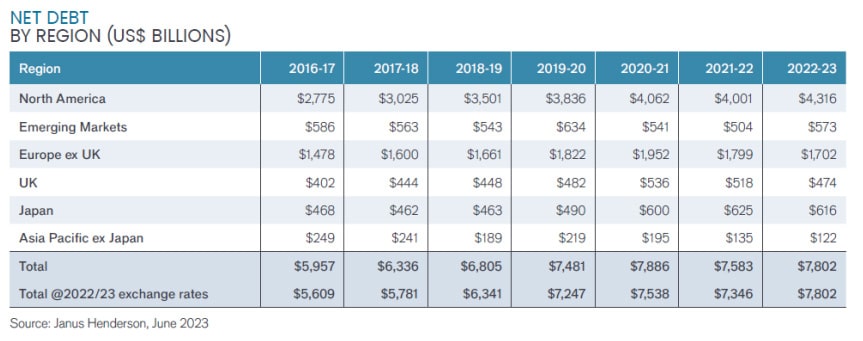
Australian corporate debt has fallen by one sixth, while global debt has risen to almost USD$8 trillion, according to the 2023 Janus Henderson Corporate Debt Index.
Globally, companies around the world took on USD$456 billion1 of net new debt in 2022/23, pushing the outstanding total up 6.2% on a constant-currency basis to a record USD$7.80 trillion.
The result stands opposed to the borrowing habits of Australian businesses, who spent 2022 repaying their borrowings, reducing Australia’s net debt from USD$62 billion to USD$48 billion. Subsequently, the nation’s corporate net debt/equity ratio fell to a relatively low 29%.
Thanks in part to record company profitability and low financing costs, more than half of Australian companies repaid borrowings in 2022, with the oil sector making the largest reductions in its debt.
By the end of the 2022 financial year, Australia’s mining companies had cash on their balance sheets – for the first time since 2014 – thanks in part to the tail end of the mining boom.
In the first half of financial year 2023, large miners such as Fortescue and BHP paid dividends earned in the previous financial year in excess of their cash flow between July and December and this meant they once again had debt on their balance sheets by the end of December.
With Australia’s local equity market dominated by cyclical sectors such as mining, the nation’s companies cannot sustain large amounts of borrowing like its international peers, resulting in a net debt/equity ratio well below its international neighbours.
Global balance sheets remain strong thanks to record profits
Global pre-tax profits (excluding financials) rose 13.6%2 to a record USD$3.62 trillion in 2022/23, though the improvement was heavily concentrated. Nine tenths of the USD$433bn constant-currency increase in profit was delivered by the world’s oil producers. A number of sectors, including telecoms, media and mining saw lower profits year-on-year. Take all together, higher global profit boosted equity capital, and this meant the global debt/equity level, an important measure of debt sustainability, held steady at 49% year-on-year, despite increased borrowing.
Also read: Australian Investors Seek Safety of Fixed Income
Cash flow declined from record levels
Across the globe, cash flow – which takes into account factors like investment and working capital – did not follow profits higher in 2022/23, dipping by 3%3 from record 2021/22 highs. Despite lower cash flow, companies distributed a record USD$2.1 trillion in dividends and share buybacks, up from $1.7trillion the year before, and bridged the gap with higher borrowing or by running down cash piles.
Higher interest rates are only slowly impacting companies
Many large companies finance their debts with bonds that have fixed interest rates (known as coupons), and this is delaying the impact of higher interest rates – only about one eighth of bonds are refinanced each year. The amount spent on interest only rose 5.3% on a constant-currency basis in 2022/23 which was significantly less than the increase in global interest rates, and interest consumed a record low 9.2% of profits4. There is significant regional variation. US companies rely more on bond financing and saw no increase in interest costs, but those in Europe, where variable-rate loans arranged by banks are common, interest costs rose by a sixth.
Outlook
The global economy is slowing as higher interest rates exert pressure on demand and on corporate profits. Higher borrowing costs and slower economic activity mean companies will look to repay some of their debts, though there will be significant variation between different sectors and between the strongest and weakest companies. Net debt is likely to fall less than total debt as cash-rich companies continue to reduce their cash piles. Overall Janus Henderson expects net debt to decline by 1.9% this year, falling to USD$7.65 trillion.
Shan Kwee, Australian Fixed Income Portfolio Manager at Janus Henderson said: ”The exact path for the Australian economy and corporate earnings remains unclear, however local companies have used the preceding period of lower interest rates to extend their debt maturities of their balance sheets, allowing them to show resilience through a period of sharply rising interest rates. The benefit to investors is that meaningful levels of income are now available to lock in which is something to be happy about. Bonds are back.
“From an Australian perspective, we feel that fixed income is becoming more attractive to local investors, who can confidently invest in fixed income for yield as we look for high quality companies with robust balance sheets, and corporate fundamentals that can weather a slowing growth environment. This is particularly true for investors willing to gain exposure to corporate bonds ahead of the impending end of the RBA’s rate-hike cycle. Not only that, but when market interest rates fall to reflect lower inflation and a slowing economy, bond prices can rise, generating capital gains too.”
1 Adjusted for constant exchange rates.
2 Adjusted for constant exchange rates.
3 Adjusted for constant exchange rates.
4 Average of last 8 years is 13.1%.































